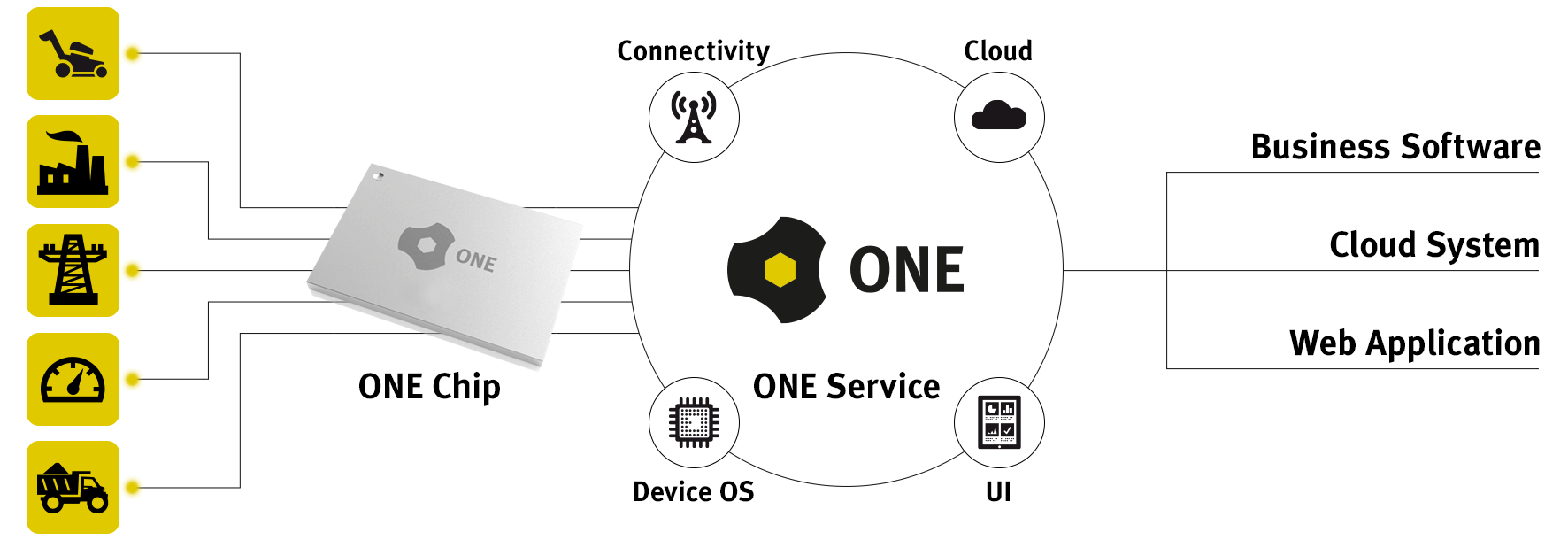Es dauert nur ein paar Minuten, …
… um die Temperatur Ihres Geräts auf einem Web-Frontend zu visualisieren.

All in ONE IoT Ökosystem
Cellular IoT für industrielle Lösungen war noch nie so einfach! Entdecken Sie eine revolutionäre Ökosphäre für seriöse Entwicklungsergebnisse. Einfache Arbeitsabläufe und 100 % Online-Entwicklung führen zu einer erheblichen Reduktion der Ressourcen für das Lebenszyklusmanagement.

… um die Temperatur Ihres Geräts auf einem Web-Frontend zu visualisieren.
// ---
// applicaion main loop triggered every second
// ---
#callback appLoop()
{
new sht31[DDE_sht31]; // Initialize the data structure
SHT3x_read(sht3x, sht31.temp, sht31.rh); // Read the temperature and humidity
DDE_sht31_write(0, sht31); // and forward them to the cloud
}
Microtronics ONE ist ein einheitliches Fundament, auf dem flexible IoT-Anwendungen gebaut werden können. Es ist mehr als nur ein Standard, ein Protokoll, ein Nachrichtensystem oder eine Geräteverwaltungsplattform. In gewisser Weise ist es all das, ganz einfach integriert. Um Microtronics ONE kennenzulernen, empfehlen wir Ihnen den Quickstart Guide und das Demo-Beispiel. Probieren Sie das Starterkit gleich aus, oder werfen Sie einen Blick in die Dokumentation.
Sowohl Microtronics selbst als auch die Technologie, haben sich seit 2006 laufend weiterentwickelt. Seit kurzem haben wir ein Produkt in unserem Portfolio, das sich speziell an Entwickler:innen richtet. Wir entwickelten industrietaugliche, Mobilfunk-gestützte IoT-Lösungen bereits bevor der Begriff überhaupt geprägt wurde, und haben mittlerweile zehntausende aktive Geräte im Einsatz. Als Partner engagiert sich Microtronics für eine nachhaltige Entwicklung und einen zuverlässigen Betrieb, was durch Zertifizierungen auf Systemebene nach ISO 9001, 14001, 27001 unterstrichen wird. Microtronics ist 100% IoT.
Das können wir Ihnen zwar nicht definitiv beantworten, aber aus Erfahrung: Die Chancen stehen gut, ja. Allgemeiner gesagt, ist Mobilfunkkonnektivität Ihre erste Wahl, wenn Sie eine zuverlässige Verbindung von einem entfernten Standort ohne kabelgebundene Netzwerkinfrastruktur, vielleicht auch ohne Stromquelle in der Nähe, letztlich von Standorten auf der ganzen Welt, herstellen müssen, um hochauflösende Daten zu übertragen.
Allerdings hat auch Mobilfunk seine Störungen und Mobilfunknetzbetreiber (MNOs) neigen nicht dazu, sich auf Verfügbarkeitsraten festzulegen. Obwohl die Konnektivität als solche enthalten ist, hängt die Servicequalität von Microtronics ONE von der Verfügbarkeit von Mobilfunknetzen ab, die von MNOs bereitgestellt wird. Dennoch verfügt Microtronics ONE über mehrere integrierte Resilienzmechanismen, wie z. B. lokale Pufferung und automatische Wiederverbindung, um vorübergehende Ausfälle zu überwinden, ohne wertvolle Datenpunkte zu verlieren und meistens, ohne dass es jemand überhaupt bemerkt.
Darüber hinaus hängt die Mobilfunkverbindung in Microtronics ONE ausschließlich von einem bestehenden Uplink ab, d. h. einem verfügbaren Mobilfunknetz. Datenschutz zur Sicherstellung von Vertraulichkeit und Authentizität, Komprimierung, zeitorientierte, ordnungserhaltende Übertragung etc. wird innerhalb des Protokolls eigenständig sichergestellt.
In Bezug auf personenbezogene Daten hat sich Microtronics voll und ganz der Einhaltung der DSGVO verpflichtet, und es steht Ihnen frei, Ihre darin gewährten Rechte jederzeit auszuüben. Darüber hinaus betreibt Microtronics seine Rechenzentren in Österreich, innerhalb der Europäischen Union und somit im Geltungsbereich der DSGVO.
Microtronics ONE ist keine Werbeplattform, es findet kein Profiling im Sinne der DSGVO statt und gelöschte Accounts werden zuverlässig aus unseren Diensten gelöscht.
Hinsichtlich des geistigen Eigentums behalten Sie als Ersteller die alleinige Kontrolle über das Design und die Implementierung jeder kundenspezifischen Anwendung, die in der bereitgestellten IDE innerhalb der Microtronics ONE-Ökosphäre entwickelt wird. Microtronics behält sich das Recht vor, Inhalte zu sperren oder zu entfernen, wenn sie gegen die Nutzungsbedingungen, die Doppelnutzung oder andere gesetzlichen Bestimmungen verstoßen.
Sie entscheiden, mit wem Sie den Inhalt teilen und wie Sie ihn lizenzieren oder vermarkten möchten. Microtronics gewährt die Nutzung der zur Verfügung gestellten Tools, Infrastrukturen, Programmierbibliotheken und Dokumentationen innerhalb des Ökosystems für die Dauer des Bestehens eines Kontos.
Folglich können Sie wählen, ob Sie Ihre freigegebene Anwendung anderen öffentlich zugänglich machen oder privat halten möchten.
Im Hinblick auf die betriebliche Integrität verpflichtet sich Microtronics zu regelmäßigen Updates sowohl für die Cloud- als auch für die Geräte-Software-Stacks. Cloud-Updates werden nach dem Ermessen von Microtronics durchgeführt und entsprechende Informationen bereitgestellt. Geräte-Firmware Updates werden angekündigt und bereitgestellt, wobei der Zeitpunkt der Installation im Ermessen des Benutzers liegt. Bei beiden Arten von Software-Updates bleibt die Datenintegrität erhalten. Jegliche Änderung der Einstellungen, die die Datenintegrität beeinträchtigen könnte, muss von Ihnen selbst vorgenommen werden und ist für den internen Support gesperrt, es sei denn, Sie geben Ihre Zustimmung. Die Verwaltung von App-Updates liegt allein im Ermessen des Benutzers.
Microtronics-Geräte können mit einer maßgeschneiderten Skriptsprache (die Skriptsprache basiert auf Pawn von CompuPhase) und einfachem Markup zur Beschreibung von Datenstrukturen nach Bedarf getrimmt werden. Stellen Sie es sich als vereinfachtes C vor. Syntaktisch ähnlich, aber typeless und ohne Strukturen, mit Referenzen aber ohne Pointer. Sie kann von C-Programmierern leicht übernommen werden. Kompiliert in eine Zwischensprache, die für eine effiziente Ausführung auf einer isolierten abstrakten virtuellen Maschine auf eingeschränkten Geräten optimiert ist.
Sowohl Ja als auch Nein, je nachdem, was Sie erreichen wollen. Das Herzstück von Microtronics ONE ist ein bewährtes, proprietäres Protokoll, das wir UTO (Universal Transferable Object) nennen. UTO ist drei Dinge auf einmal:
Bei der Verwendung von Microtronics ONE gibt es keinen direkten Kontakt mit UTO, da alles abstrahiert ist.
Deshalb:
Sie selbst. Unterstützt durch viele Hilfen, um Fehler zu vermeiden.
Zum Beispiel:
Microtronics ONE vereint Cloud-Funktionen und Servicebereitstellung, Konnektivität und mobiles Datenvolumen, Wartung der Geräte-Firmware und Tenancy-Aspekte in einer Abrechnungseinheit: Data Operations. Data Operations ermöglichen ein faires, nutzungsorientiertes Verbrauchsmodell, das mit dem Umfang der Nutzung des Produkts skaliert.
Eine Data Operation ist eine Aktion auf einem Nutzungsdatenpunkt. Das heißt, Daten, die für Ihren Anwendungsfall relevant sind. Die Übertragung eines einzelnen Datenpunktes in die Cloud stellt eine Data Operation dar. Weitere Kombinationen von Datenpunkten sind Data Operations. Das Lesen über die API, Benutzer- oder andere Schnittstellen verbraucht ebenfalls Data Operations.
Data Operations werden mithilfe von Paketen aufgeladen und dann je nach Anwendungsfall entnommen. Sie können beeinflussen, wie ressourcenintensiv Ihre Anwendung ist, indem Sie die Empfindlichkeit, die Messintervalle, die Caching-Strategien usw. steuern, die Belastung unserer Systeme reduzieren und somit einen optimierten, kostengünstigen Betrieb sicherstellen. Microtronics ONE stellt Ihnen Indikatoren, eine historische Übersicht und eine Startbilanz zur Verfügung, welche Ihnen helfen, den monatlichen Verbrauch abzuschätzen.
Um Microtronics ONE interaktiv erleben zu können, brauchen Sie nicht nur die Dokumentation, sondern auch ein Starterkit. Das Starterkit ist ein Stück Hardware, das Folgendes demonstrieren kann:
Sie erhalten eine Startguthaben an Data Operations (siehe Frage oben), für eine einfache erste Bewertung von Microtronics ONE. Wir könnten noch so viel erklären, Sie werden es trotzdem besser verstehen, wenn Sie es einfach ausprobieren. Aber wir wollen, dass Sie wissen, worauf Sie sich einlassen, bevor Sie sich mit größeren Paketen auseinandersetzen. Daher ist der bevorzugte erste Schritt auf dem Weg zum Microtronics ONE ein erstes Kennenlernen mit einem Starterkit.
Von da an können Sie in Ihrem eigenen Tempo fortfahren. Verlängern Sie die Evaluierung, stocken Sie die Data Operations auf, geben Sie es auf, ohne eine Art verstecktes Abonnement abschließen zu müssen, oder gehen Sie mit Ihren eigenen Hard- und Software-Ideen zu einem aufwendigeren Prototyping über.
Microtronics Engineering GmbH
Hauptstraße 7
3244 Ruprechtshofen
Österreich
Microtronics Engineering GmbH
Hauptstraße 7
3244 Ruprechtshofen
Österreich